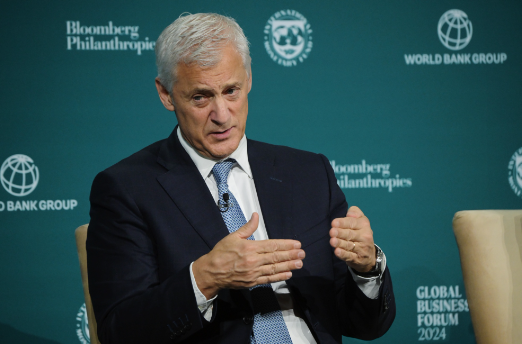
封面故事:澳大利亚维多利亚州麦田旁,由Neoen SA运营的维多利亚大电池工厂内的特斯拉股份有限公司超级电池组。摄影师:卡拉·戈特根斯/彭博社
Tesla Inc. Megapack batteries at the Victorian Big Battery site operated by Neoen SA next to a wheat field in Victoria, Australia. Photographer: Carla Gottgens/Bloomberg
原标题:彭博推送 | 气候金融的规模化,就此开启了吗?
译文
麦肯锡认为,需要很多技术“去碳化”,关于已经存在的全球变暖的主要源头问题。这些去碳化的措施,只是需要被规模化。您可以在彭博官网找到更多资讯。
再者,始终陪伴着对于 Helene 飓风的持续报导,包括气候专家观点,这些人家里都被灾难袭击了。如果您想获取气候及能源的新闻,请订阅。
continuing coverae 持续报导
aftermath 后果,余波
01 “更大规模”气候技术现在必须了
Alastair Marsh
做大事还是回家?这是气候变化给出的选择。仅仅在这个特殊的案例,只采取一半的措施,意味着不再有回家的时候。
很多技术需要“去碳化”,关于已经存在的全球变暖主要源头问题,这些去碳化措施,需要被推出来,同时,规模与挑战相称。依据麦肯锡的说法,如果碳捕获,温度升高,并且可能大量贮存,他们能够减少多达 90% 的全国温室气体排放。
“这不仅仅是我们要找的速度” Mark Patel,麦肯锡旧金山分部的高级合伙人,关注气候相关技术。“我们需要在全球找到更大规模。我们需要激励我们自己,变得更快、更具规模。”
麦肯锡认为,90% 温室气体排放的减少,能由 12 项技术处理。然而,其中只有 10% 是具有商业竞争性的,另外 45% 是商业可用的,但是需要进一步的成本缩减,变得更具有竞争力,并且是继续碳的现有技术。咨询公司表示(The remainder 类似于“会议纪要”),是很有潜力 的事情,但还是在发展早期阶段。
为了最大化气候技术的减排能力,无论这个技术是不是电池技术,太阳能技术,或者可持续能源,将这些行业业务商业化、规模化至关重要,Patel 说到。
emissions-cutting capacity 减排能力
is paramount 至关重要
Patel 上周在气候周会上传递了一个信息,他们接受了一项投资,多于 100 个投资人和企业家,在曼哈顿底层的麦肯锡办公室里。在一个能见到纽约港的会议室举行,景色还能见到自由女神像,头上是巨大的维拉萨诺大桥,这可是非常理想的地点,去谈论规模。
the Statue of Liberty 自由女神像
New York Harbor 纽约港
the huge Verrazano Bridge 维拉萨诺大桥
“如果我们希望产生影响,在一个构造有意义的专业术语的时代,例如,CO2 减排,以及为了完成 2050 年目标所产生的清晰的路径。除非我们又快又有规模,不然是不起作用的”他告诉观众。
abatement 减排
abatement of tax 减税
trajectory 弹道
但是这并非是将所有事情放大。麦肯锡认为,我们依然学习了前几代人气候技术领域增长的方法,即太阳能,风能电池,为新兴技术构造了一副地图,变得更加具有成本竞争力,相较于化石燃料而言。麦肯锡发现,所有 100% 部署提升,能产生至少 70% 的成本缩减。
nascent tech 新兴技术
divine a roadmap 构造一副地图
Patel 认为这种关系是可预测的,以及可靠的,以及能够给到投资人信心,快速扩张会导致不成比例的成本缩减,以及更快开启被市场采用。信心是很关键的,因为气候 技术投资并非一直起作用,以这种方式的话。
“这是很显然的,更大规模,以及单位成本降低是趋势,但是在气候技术,我们在很多场景都有太多挑战,这些场景很有潜力的技术并没有战胜独一无二的操作(get beyond first-of-a-kind operations),也没有达到 这样的程度,即单位成本能与化石燃料、已有燃料相抗衡。”Patel 说到。
existing incumbents 在职人员
Patel 并非唯一的人,说到需要增加解决气候变化问题的投入规模。
在气候变化讨论周期间,渣打银行 CEO Bill Winters 说到,那些提升自发自愿的碳市场的凝聚力、信用的工作和努力,这些工作被吹捧为解锁气候金融的“关键问题”,仅仅只拥有有限的影响力,除非那个市场有序增长,从现有市场的规模开始。
touted 吹捧
“如果没形成规模,重点是什么?” Winter 说到,“如果你没有投入万亿,我们就不会去产生我们知道我们必须产生的影响。”
相关的,Frederick,GenZero CEO,这家公司是投资公司,由 Temasek 创办。一场在纽约的面试中说到上述的话,以及关于想要获得气候影响的规模必须包括自然界中的碳固存(the carbon sequstration)。基于自然的解决方案,能够包括保护和重建自然生态系统,例如,森林,或者隔离在红森林。
mangrove to sequester 隔离在红森林
“如果你自己有理论,关于规模化的时候什么是必要的,才能产生不同,那么,自然本身变成非常重要的部分,在这场讨论中。” 他说到。
在纽约讨论也涉及,如何搜集核能源,作为一项关键的低碳资源,同时,如何展示一项里程碑式的承诺,从去年联合国气候峰会开始计算,目标是 2030 年全球可再生能源翻三倍。
landmark pledge 里程碑式的承诺
“在气候变化问题的斗争上,我们必须将时间看作一个常量,” Patel 说到,“但是我们能影响的变量,规模和成本,正在努力影响速度。”
简要谈论可持续金融
如果你在期待联储缩减利率,来松绑绿色转化领域的钱包口子(purse strings 意指预算的使用)。你不应该去期待,利率缩减周期会突然恢复绿色转化领域,依据 Barry Norris 说辞,他是 英国对冲基金 Argonaut Capital创始人、合伙人、首席投资官。“过去几年,能源转换洞见者,坚信行业问题的根源仅仅来自于高利率,” Norris 在一个 面试中说到,“利率现在降低了,逻辑上,这个领域市场的留存下的会变得更好。取而代之的,洞见者也会重新找到政府,所要更多的津贴。”
野火正在摧毁美国的本土植物,对人类和动物产生严重后果。尽管,一些小的行业正在试图成为弄潮儿(导向行业趋势),被超越了 —— 现在私人资本又到达了。
are laying waste 摧毁
dire consequence 严重后果
一些债券投资人很可能面临更多违约风险,比起他们模型显示的数据。这是有顾虑的,来自于越来越多的研究人员,研究气候变化关于债券市场的影响。
净额的目标需聚焦在资本适应,以至于资产及基础设施变得更加有抵抗力,在应对物理冲击的时候,这些物理冲击来自于气候变化。
原文
McKinsey says many of the technologies needed to decarbonize the primary sources of planet-warming gases already exist — they just need to be scaled. Read on for more details — and share this story online at Bloomberg.com.
Also, keep up to date with continuing coverage of Hurricane Helene aftermath, including a view from the climate scientists whose homes have been hit by the disaster. For unlimited access to climate and energy news, please subscribe.
‘Greater scale’ climate tech is now a necessity
By Alastair Marsh
Go big or go home: That’s the scenario posed by climate change. Only in this particular case, taking half-measures means no more home.
Many of the technologies needed to decarbonize the primary sources of planet-warming gases already exist—they just need to be rolled out at a size commensurate with the challenge. According to McKinsey & Co., if carbon capture, heat pumps and the like were “deployed at scale” they could reduce as much as 90% of global greenhouse-gas emissions.
“It’s not just speed that we’re looking for,” said Mark Patel, a senior partner at McKinsey in San Francisco who focuses on climate-related technologies. “We need to intentionally seek greater and greater scale. We need to motivate ourselves to go faster and go bigger.”
McKinsey says that the 90% reduction in emissions can be delivered by 12 categories of climate technologies. However, just 10% of those are commercially competitive and a further 45% are commercially available but require further cost reductions to become competitive with carbon-intensive incumbent technologies. The remainder “hold great promise,” but are in earlier stages of development, according to the consulting group.
To maximize the emissions-cutting capacity of climate tech, whether it be batteries, solar or sustainable fuels, getting them to commercial scale is paramount, Patel said.
It was a message he delivered last Wednesday at a Climate Week reception for more than 100 investors and entrepreneurs in McKinsey’s office in lower Manhattan skyscraper. Held in view of New York Harbor, framed by the Statue of Liberty and the huge Verrazano Bridge beyond, it was an ideal location to talk about scale.
“If we want to have an impact in a time frame that’s meaningful in terms of CO2 abatement and to have a trajectory for the 2050 goal, it won’t work unless we mix speed with scale,” he told those in attendance.
But it’s not just about supersizing everything. McKinsey says it has studied the growth of an earlier generation of climate technologies, namely solar, wind and batteries, to divine a roadmap for more nascent tech to become cost competitive with fossil-fuel. McKinsey found that every 100% increase in deployment can yield at least 70% of cost reductions.
Patel said this relationship is predictable and reliable and should give investors confidence that rapid scaling will lead to disproportionate cost cuts and unlock faster adoption. And confidence is key because climate-tech investing hasn’t always worked this way.
“It’s intuitive that the more scale, the lower the unit cost should become, but in climate tech we have the challenge of so many situations in which promising technology didn’t get beyond first-of-a-kind operations and didn’t reach anywhere near a unit cost that has parity with the fossil alternative or existing incumbents,” Patel said.
And Patel isn’t the only one talking about the need to scale solutions to climate change.
During Climate Week, Standard Chartered Plc Chief Executive Officer Bill Winters argued that efforts to improve the integrity and credibility of the voluntary carbon market, which has been touted by some as a key vehicle for unlocking essential climate finance, will only have a limited impact unless that market grows in orders of magnitude from its current size.
“If it’s not scaled, what’s the point?,” Winters said. “If you don’t get the billions and billions and billions put to work, we’re simply not going to make the impact that we know we have to make.”
Relatedly, Frederick Teo, the CEO of GenZero, an investment company founded by Temasek, said in an interview in New York that any discussion of having sizable climate impacts must include the carbon sequestration power of nature. Nature-based solutions can include conserving or restoring natural ecosystems like forests or mangroves to sequester CO2.
“If you have a theory of change around what is necessary at scale today to make a difference, then nature becomes a very important part of the conversation,” he said.
Discussions in New York also touched on how to ramp up nuclear energy capacity as a critical low-carbon fuel, as well as how to deliver on a landmark pledge from last year’s United Nations’ climate summit to triple global renewable energy capacity by 2030.
“In the equation of fighting climate change, we have to take time as a variable that is a constant,” Patel said. “But variables we can affect are scale and cost, and the speed at which we progress.”
Sustainable finance in brief
So if you were expecting US Federal Reserve rate cuts to loosen up green transition purse strings, think again. It’s wrong to expect that a cycle of interest-rate cuts will suddenly revive the green transition, according to Barry Norris, the founder and chief investment officer of UK hedge fund Argonaut Capital Partners. “For the last few years, energy-transition insiders believed that the problems in the industry stemmed purely from high interest rates,” Norris said in an interview. “Interest rates are now falling, so logically sentiment in this part of the market should be better. Instead, the insiders are going back to governments asking for more subsidies.”
Wildfires are laying waste to America’s native plants, with dire consequences for animals and humans. Though a small industry is trying to turn the tide, it’s overmatched—and now private equity has arrived.
Some bond investors may be facing bigger default risks than their models indicate. It’s a concern voiced by a growing number of researchers studying the impact of climate change on bond markets.
Net-zero goals should focus on funding adaptation to make property and infrastructure more resilient to the physical impacts of climate change.
原文链接
长按/扫码,有您的支持,我们会更加努力!


|
